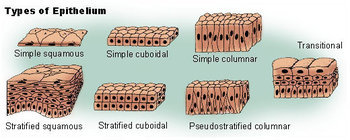Epithelium
|
|
In zootomy, epithelium is a tissue composed of a layer of cells. Epithelium can be found lining internal (e.g. endothelium, which lines the inside of blood vessels) or external (e.g. skin) free surfaces of the body.
The outermost layer of our skin is composed of dead squamous epithelial cells, as are the mucous membranes lining the inside of mouths and body cavities. Other epithelial cells line the insides of the lungs, the gastrointestinal tract, the reproductive and urinary tracts, and make up the exocrine and endocrine glands.
Functions of epithelial cells include secretion, absorption and protection. Epithelial cells sit on a basal lamina (formerly called a basement membrane).
| Contents |
Classification
Epithelial cells are classified by the following three factors: -
- Shape
- Stratification (number of layers)
- Specialization
Shape
- Squamous: Squamous cells are thin cells with an irregular flattened shape. The one cell layer of simple squamous epithelium is a minimal barrier to diffusion. Places where squamous cells can be found include the alveoli of the lungs, the filtration of the kidneys, and the major cavities of the body. These cells are relatively inactive metabolically and are associated with the diffusion of water, electrolytes, and other substances.
- Cuboidal: As the name suggests, these cells have a shape similar to a cube, meaning its width is the same size as its height. The nuclei of these cells are usually located in the center.
- Columnar: Simple columnar epithelium is made up of a single layer of cells that are longer than they are wide. The nucleus is also closer to the base of the cell. The small intestine is a tubular organ lined with this type of tissue. Unicellular glands called goblet cells are scattered throughout the simple columnar epithelial cells and secrete mucus. The free surface of the columnar cell has tiny hairlike projections called microvilli. They increase the surface area for absorption.
Stratification
- Simple: There is a single layer.
- Stratified: More than one layer of cells. The superficial layer is used to classify the layer. Only one layer touches the basal lamina. Stratified cells can usually withstand large amounts of stress.
- Pseudostratified: This is used mainly in one type of classification (pseudostratified columnar epithelium). There is only a single layer of cells, but the position of the nuclei gives the impression that it is stratified.
- Transitional: This is a specialized type of epithelium found lining organs that can stretch, such as the bladder or the ureter of mammals. Since the cells can slide over each other, the appearance of this epithelium depends on whether the organ is distended or contracted: if distended, it appears as if there are only a few layers; when contracted, it appears as if there are several layers.
Specialization
- Keratinization / Cornification: Cells contain keratin (a cytoskeletal protein). This process occurs mainly in skin, since it provides a tough, impermeable barrier.
- Ciliated: See Cilia
- Brush Border / Microvilli: See Microvilli. These are found in cells that play an absorptive role since they greatly increase the surface area. Found in intestine and kidney tubules.
- Stereocilia: Similar to cilia, except they have no internal structure and are non-motile. Found in vas deferens and epididymis.
Examples
- Simple Squamous: Found in blood vessels & lymph channels (called endothelium) and body cavities (called mesothelium)
- Keratinized Stratified Squamous: Found in human skin (specifically, the dead superficial layer)
- Stratified Squamous: Found in human trachea
- Simple cuboidal: Found in thyroid follicles
- Stratified Cuboidal: Exclusively found in sweat gland ducts
- Ciliated Simple Columnar: Found in intestine and kidney (specifically, distal convoluted tubule)
- Stratified Columnar: Ducts of submandibular glands
- Transitional: Specialized to distend (stretch) as the urinary bladder fills

